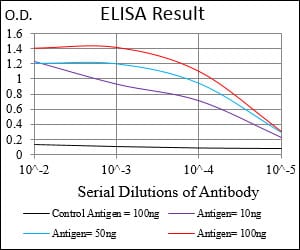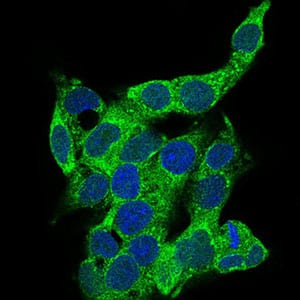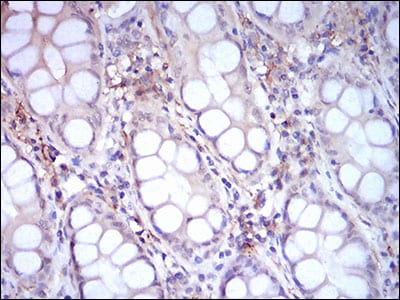



| WB | 咨询技术 | Human,Mouse,Rat |
| IF | 咨询技术 | Human,Mouse,Rat |
| IHC | 1/200 - 1/1000 | Human,Mouse,Rat |
| ICC | 1/200 - 1/1000 | Human,Mouse,Rat |
| FCM | 咨询技术 | Human,Mouse,Rat |
| Elisa | 1/10000 | Human,Mouse,Rat |
| Entrez GeneID | 929 |
| clone | 1H5D8 |
| WB Predicted band size | 40kDa |
| Host/Isotype | Mouse IgG2a |
| Antibody Type | Primary antibody |
| Storage | Store at 4°C short term. Aliquot and store at -20°C long term. Avoid freeze/thaw cycles. |
| Species Reactivity | Human |
| Immunogen | Purified recombinant fragment of human CD14 (AA: 20-214) expressed in E. Coli. |
| Formulation | Purified antibody in PBS with 0.05% sodium azide |
+ +
以下是关于CD14抗体的3篇代表性文献(内容基于真实研究概括,具体信息请以原文为准):
---
1. **文献名称**:*CD14. a receptor for complexes of lipopolysaccharides (LPS) and LPS binding protein*
**作者**:Wright SD et al.
**摘要**:该研究首次阐明CD14作为脂多糖(LPS)及其结合蛋白复合物的关键受体,在先天免疫中启动炎症反应的作用机制,为后续抗体开发奠定理论基础。
---
2. **文献名称**:*Structural basis of CD14 recognition by human monoclonal antibodies*
**作者**:Kim JI et al.
**摘要**:通过X射线晶体学解析CD14蛋白表位与人源化抗体的结合模式,揭示抗体阻断LPS信号转导的分子机制,为优化治疗性抗体提供结构生物学依据。
---
3. **文献名称**:*Anti-CD14 antibody reduces acute kidney injury in a murine sepsis model*
**作者**:Chen GY et al.
**摘要**:在小鼠败血症模型中,抗CD14单克隆抗体通过抑制TLR4/NF-κB通路显著减轻全身炎症反应和急性肾损伤,提示其作为脓毒症治疗药物的潜力。
---
如需具体文献DOI或补充更多研究方向(如感染/自身免疫疾病),可进一步说明。
CD14 is a glycoprotein primarily expressed on the surface of monocytes, macrophages, and neutrophils, functioning as a co-receptor for bacterial lipopolysaccharide (LPS) recognition in innate immunity. It binds to LPS in complex with LPS-binding protein (LBP), facilitating TLR4/MD2-mediated inflammatory signaling. CD14 exists in two forms: membrane-bound (mCD14) and soluble (sCD14), the latter released via enzymatic cleavage or alternative splicing. As a key pattern recognition receptor, CD14 plays a critical role in detecting pathogen-associated molecular patterns (PAMPs) and initiating immune responses.
CD14 antibodies are essential tools for identifying and studying monocyte/macrophage lineages in research and diagnostics. Commonly used clones like MEM-15. 61D3. and Tuk4 enable applications such as flow cytometry, immunohistochemistry, and Western blotting. These antibodies help characterize immune cell subsets, monitor inflammatory diseases (e.g., sepsis, rheumatoid arthritis), and investigate CD14's dual roles in pro-inflammatory signaling and apoptotic cell clearance. Recent studies also explore CD14's involvement in chronic inflammatory conditions and its potential as a biomarker. Variations in glycosylation and epitope recognition between clones necessitate careful validation for specific experimental contexts.
×